Imagine cheese carefully handcrafted by someone trained in a top artisanal cheesemaking course in Wisconsin. The individual is so passionate about cheeses that each vat of curd is stirred by hand, and the product is closely monitored throughout the entire cheesemaking process.
Their mission is to preserve the working landscape of their small hometown through flavors and traditional processes. It is an art. And this story makes the cheese that much more enjoyable to the consumer.
Perhaps even add to the narrative that the milk used is fresh from a local grass-fed pure Jersey or Brown Swiss herd where only the best dairy practices are employed. By adding in details about the farm and farm family and regional traditions — like New Glarus, Wis.-area farms, which are often run by descendants of Swiss immigrants — you have a story that consumers want to hear.
The International Dairy Deli Bakery Association (IDDBA) recently spotted this technique in action through Yodelay yogurt. The company even promotes the farm that supplies its milk on its website, stating: “They love what they do, and so does their herd.”
Most likely, there is a similar story for many dairy processors, but it isn’t told. The attention to detail and dedication to the mission is inspiring; it has a way of making you feel more connected to the product, right? And because most consumers won’t ever visit a cheese processing plant, it’s important to tell the story of the cheese.
Start at the beginning
One important story to tell about cheese is its origins. Today’s consumers have increasingly become interested in “local.” In fact, local food sales in the United States grew from $5 billion to $12 billion between 2008 and 2014. They are predicted to jump to $20.2 billion by 2019, outpacing the growth of the country’s total food and beverage sales, according to Packaged Facts, a division of Rockville, Md.-based MarketResearch.com.
“Local has become a shorthand descriptor that makes food sound high-quality, fresher, more authentic, trustworthy, environmentally friendly and supportive of the local community,” a recent report from the company states.
The report also points out that almost half of people surveyed said they are willing to pay up to 10% more for locally grown or locally produced foods, and almost one in three said they are willing to pay up to 25% more.
Shoppers want to support local farmers, whether it be for a belief that local food leaves a smaller carbon footprint because the food travels fewer miles, or because they feel connected with the food in knowing where it comes from. Dairy processors can help build that emotional attachment through transparency, a pathway to consumers’ trust. And for some consumers, local correlates to transparency that is about personal health preferences (e.g., avoiding GMOs).
Think clean
Today’s shoppers also appreciate information that indicates sourcing and freshness attributes. They want simple, clean labels with ingredients they can pronounce. Clean labels, however, can convey more information than ingredients. For example, some qualities that could be included on a clean cheese label are:
- Healthfulness (rBST-free, grass-fed).
- Authenticity (natural, crafted, artisanal).
- Environmentally friendly status (organic).
It’s easier for many shoppers to make a purchase when they can feel good about it. Informative and clean labels can directly target this type of consumer. They want to understand what is in the product, where it comes from and, perhaps, how they’ve impacted the world because of the purchase.
Tout health benefits
Cheese also has important health and wellness benefits, but they’re often skipped over in marketing campaigns. As more and more people move away from processed food and gravitate toward more natural whole foods, cheeses are seeing an escalation in popularity.
It is often said that cheese is the ultimate clean-label product, as it naturally has very few ingredients — often only milk, cultures, rennet and salt. Even the lactose-
intolerant can eat certain cheeses, which may not be news to you, but not every consumer has received this information.
The main idea is that consumers want to know more. Labeling a cheese as “healthy” is no longer enough; consumers want to know the specifics.
Appeal to ‘superconsumers’
Beyond the average consumer, superconsumers — those who are heavy users and highly involved — have unique attitudes that are reflected in their lifestyles. IDDBA’s latest original research, “The Superconsumer Opportunity in Dairy, Deli, and Bakery,” shows how these shoppers use food to improve their lives. Superconsumers over-index in volume, sales and profits because they:
- Eagerly look for new products.
- Happily pay price premiums.
- Shop the category frequently.
- Have above average category knowledge.
- Are more open to marketing messages.
- Can articulate and anticipate latent demand.
Specifically, what IDDBA learned about dairy superconsumers is that they believe dairy is healthful. Colleen, a mother, described how dairy satisfies her child’s craving for a sugary sweet snack with chocolate milk or fruit yogurt. Others use dairy as extra protein to fuel their athletic endeavors.
Thus, a superconsumer can provide retailers and manufacturers with insight into innovations that can be used to grow dairy and cheese sales. Sales can be gained by simply teaching greater use of a product such as pushing the positive nutritional qualities — the marketing message could increase the dairy spend index to 165, just halfway to a superconsumer’s spend index, and the industry could experience 11% growth or $5.2 billion in sales.
The research also found that cheese superconsumers represent 10% of households yet drive 23% of sales. In addition, they spend 2.3 times more money than other shoppers ($351 annually).
If we can get the right marketing messages to the approximately 20% of households of people who often really like cheese, but spend less (about $177 per year), it’s possible to increase sales. The consumers already like the product; they just don’t buy a lot right now. A little push from intriguing cheese marketing could activate these potential superconsumers to buy more.
Through IDDBA research, we have found that cheese superconsumers use cheese to enhance food — from putting extra specialty cheeses on frozen pizza to adding blue cheese on broccoli. To them, more cheese and more interesting flavors and varieties are always better.
Are there ways to activate American consumers to eat more cheese? Today, Americans eat about 35 pounds of cheese per year on average. While this is the highest amount ever — more than double the amount consumed in 1975 — it still does not come close to the average per-capita consumption in Europe — 43 pounds per year. There clearly is room for American cheese consumption to grow.
Perhaps potential cheese superconsumers could be leveraged by taking a page from the restaurant playbook. In the mid-90s, with help from Rosemont, Ill.-based Dairy Management Inc. (DMI), Pizza Hut debuted its cheese-stuffed crust, which led to a 7% increase in sales. DMI currently estimates that an additional 250 million pounds of cheese would be sold if only one more ounce of cheese were added to every pizza sold in a year.
Since versatility is a contributing factor to the growing demand for cheese worldwide, perhaps it is time to remind American consumers about how cheese can add flavor to just about any food. It might be time to revamp the early 90s slogan of America’s Dairy Farmers’ National Dairy Board, “Cheddar makes everything better.”
By reminding consumers about how to use cheese, particularly specialty cheese, as a part of every meal, cheese consumption and sales could increase. If the potential superconsumer spend index increased to 175, just halfway to the superconsumer spend index, the industry could experience 12% growth, or approximately $2.3 billion in sales.
A natural fit for snack time
California Milk Advisory Board consumer research shows cheese is nearly a universal fit as a nutritious, portable and delicious snack in the United States, Mexico and even Asia. A single-serve portion marketed as a portable protein snack covers consumer interests: convenience, health and wellness. Cheese has calcium for strong bones and protein for strong muscles.
Single-serve packaging is popular as consumers become increasingly busy. A study conducted by Nielsen revealed that 36% of consumers like packaging that allows food to be eaten on the go, and 23% often buy individually portioned packs.
According to a Nielsen snacking study, cheese ranked third in sales ($17.3 billion) among all snack categories, beating cookies, crackers and ice cream. Continue to steer consumers in the direction of cheese as a convenient portable option in the form of string cheese, prepackaged cheese slices and other varieties.
Playing on the idea of snacking is the idea of mixing and matching your favorite foods together. Today’s U.S. retail purchaser is looking for variety and a unique selection when he or she shops a cheese department. Show cheese’s power to be quite versatile, depending on what is added to it, or to what dishes it is added.
If you look around at food this year, you’ll see that a lot of it has heated up. Yes, spice will continue to grow this year. Hot Cheetos are all the rage; what about a spicy Cheetos cheese? Or if you like to keep things traditional — and see success with Italian-type cheeses such as Parmesan, mozzarella and Romano — keep an eye on other Italian-type cheeses for simpler variation.
Different varieties of Hispanic cheeses, according to Chicago-based IRI, DMI and the Madison, Wis.-based Dairy Farmers of Wisconsin, such as Oaxaca and Mexican are the fastest-growing cheese types. The interest could be attributed to increased consumer knowledge gained from cooking and travel shows. In fact, new combination flavors, as well as more ethnically based varieties, have created excitement among cheese lovers. The creative marketing behind this could be about spicing up consumers’ lives with cheese.
Don’t let the mixing stop there! Try a collaboration with other cheesemakers, too. Collaboration among cheesemakers, as well as between cheesemakers and retailers, is growing and is a great way to drive innovation and sales.
In the summer of 2016, Emmi Roth, Fitchburg, Wis., and Meister Cheese, Muscoda, Wis., united to capitalize on each of their strengths to launch the Kindred Creamery line. Meister Cheese makes the product, while Emmi Roth uses its marketing expertise to tell the story and sell the cheese at retail. The line features cheese made from milk produced by partner dairy farms adhering to standards called “Cows First.”
As shoppers seek more information about their foods’ origins, collaborations have been developing between farmers and restauranteurs as well. There are unlimited opportunities for retailers to partner with cheese suppliers, cracker suppliers, meat suppliers and suppliers of anything else that can be tied in with cheese (nuts, dried fruits, etc.)
In trends, we see what consumers do, and do not, like about their cheeses. Presumably, processors are making cheese with intention to please. Find that story that will connect everyone to your originality and your brand.
What is the impact of a dairy superconsumer?
Dairy superconsumers are the 10% of households who drive 22% of the total dairy spend. They:
- Spend 2.2 times more ($634/year).
- Purchase seven different subcategories.
- Shop at five different stores.
Source: IDDBA and The Cambridge Group.
What’s the impact of a cheese superconsumer?
Cheese superconsumers are the 10% of households who drive 23% of the total cheese spend. They:
- Spend 2.3 times more ($351/year).
- Purchase 10 subcategories.
- Shop at four different stores.
Source: IDDBA and The Cambridge Group.






